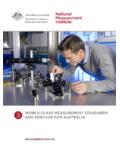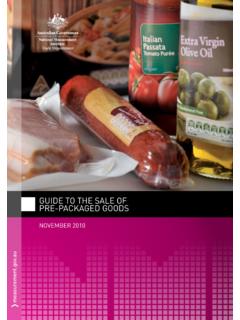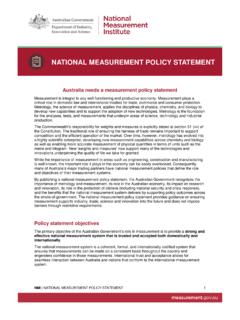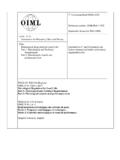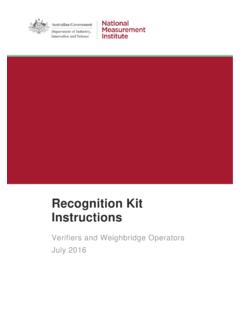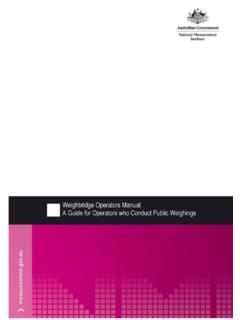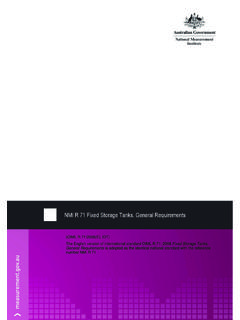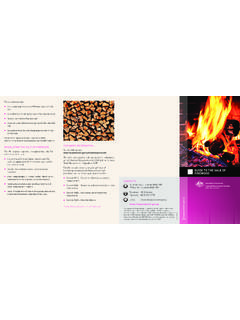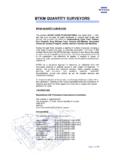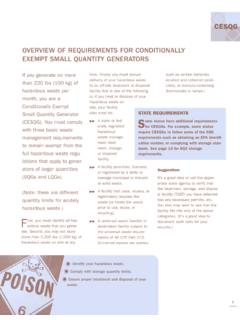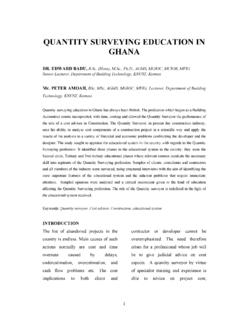Transcription of GUIDE TO THE AVERAGE QUANTITY SYSTEM IN AUSTRALIA
1 TO THE AVERAGE QUANTITY SYSTEM IN AUSTRALIA GUIDE TO THE AVERAGE QUANTITY SYSTEM IN AUSTRALIA 2010 This GUIDE to the AVERAGE QUANTITY SYSTEM (the GUIDE ) contains general information only and should not be relied upon for the purposes of a particular matter. The GUIDE does not provide legal advice and is not to be relied upon as a source of legal advice. It is provided as a general GUIDE only and as such any person reading this GUIDE should rely upon their own judgment and make their own inquiries including seeking relevant professional advice before entering into any arrangements or making any commitment on the basis of any of the material in this GUIDE . Nothing in this GUIDE shall be taken in any way to replace the provisions of the National Measurement Act 1960 (Cth), the National Trade Measurement Regulations 2009 (Cth) and any other legislative instruments made pursuant to the National Measurement Act 1960.
2 Commonwealth of AUSTRALIA 2010 This work is copyright. Apart from any use as permitted under the Copyright Act 1968, no part may be reproduced by any process without prior written permission from the Commonwealth. Requests and inquiries concerning reproduction and rights should be addressed to the Commonwealth Copyright Administration, Attorney General s Department, Robert Garran Offices, National Circuit, Canberra ACT 2600 or posted at GUIDE TO THE AVERAGE QUANTITY SYSTEM IN AUSTRALIA 2010 CONTENTSMESSAGE FROM THE GENERAL MANAGER 2 ABOUT THIS GUIDE 3 BACKGROUND 3 WHAT IS AQS? 4 HOW IS AQS DIFFERENT FROM THE UTML SYSTEM ? 4 WHAT DOES AQS MEAN FOR MY BUSINESS? 5 DUE DILIGENCE 5 WHAT DOES AQS REQUIRE? 6 THE AQS MARK 6 SHORTFALL 6 AQS THRESHOLD 6 AQS SAMPLING PROCEDURES FOR NMI INSPECTORS 7 AQS TEST PROCEDURES FOR NMI INSPECTORS 7 EXAMPLES OF AQS TESTING FOR NMI INSPECTORS 8 AQS TESTS FOR WEIGHT AND VOLUME 8 AQS TESTS FOR NUMBER 8 GLOSSARY 10 MORE INFORMATION 12 MESSAGE FROM THE GENERAL MANAGEROn 1 July 2010, the new national SYSTEM of trade measurement commenced under the administration and regulatory oversight of the National Measurement Institute (NMI)
3 A division of the Australian Government s Department of Innovation, Industry, Science and is AUSTRALIA s peak measurement organisation, responsible for maintaining the nation s primary standards of measurement and for providing the legal and technical framework for the dissemination of those standards. NMI is the only one-stop shop for all disciplines of measurement in AUSTRALIA analytical, biological, chemical, physical and legal. We provide measurement expertise, calibration services, chemical and biological analyses and pattern approval testing. Under the national SYSTEM of trade measurement, and with the support of industry, the Australian Government introduced regulations which for the first time allow businesses the choice to adopt the AVERAGE QUANTITY SYSTEM (AQS).AQS is an internationally recognised SYSTEM for sampling and testing of groups of packages to determine whether, on AVERAGE , they contain the quantities with which they are takes its responsibility for ensuring compliance with the trade measurement regulatory framework very seriously.
4 We produce concise and timely communications on business obligations. This GUIDE provides a summary of new AQS regulations and will be useful for those who need to understand the AQS and how it affects them. Dr Val rie Villi reGeneral Manager, Legal Metrology Branch ABOUT THIS GUIDEThis GUIDE has been prepared by the National Measurement Institute (NMI) to assist businesses in understanding the AVERAGE QUANTITY SYSTEM (AQS) provisions of the new national trade measurement legislation introduced in 2009. The National Measurement Act 1960 establishes a national SYSTEM of units and standards of measurement and provides for the uniform use of those units and standards throughout AUSTRALIA . The National Measurement Regulations 2009 prescribe the Australian legal units of measurement, while the National Measurement Guidelines prescribe the basis on which units of measurement and prefixes may be combined to produce an Australian legal unit of 1 July 2010, businesses such as manufacturers, packers and importers will be able to apply AQS as a SYSTEM of measurement and to label products accordingly as an AQS measure.
5 The GUIDE is for general advice only and is not a substitute for the responsibility of users to consult the national trade measurement legislation and to exercise their own skill and care, or seek professional advice, in considering both legal obligations and due diligence defences for their recent decades, international trade in pre-packed foods and beverages has increased in scale and importance compared with trade in bulk food commodities and now accounts for over 75% of the global trade in agricultural foods. Accordingly, the issues of accurate measurement and labelling of these packages (known internationally as prepackages) is also becoming increasingly important. The introduction of AQS in AUSTRALIA allows businesses to align their practices more closely with those in other countries. ABOUT THIS GUIDE WHAT IS AQS?
6 The AVERAGE QUANTITY SYSTEM is an internationally agreed method of determining the measurement of pre-packed articles with a constant nominal content . This means it provides confirmation of the measurement or QUANTITY of goods sold by measure (weight, volume, length or area) or count (number of items). AQS is based on recommendations developed by the International Organisation of Legal Metrology (OIML) and is intended for use in large-scale packaging plants where goods (for example, breakfast cereals) are packed in the same QUANTITY in large numbers. After extensive industry and consumer consultation, the Australian Government decided to introduce AQS on a voluntary basis. Under the national trade measurement legislation, manufacturers, packers and importers can choose to: continue with their current SYSTEM of shortfall calculation based on the Uniform Trade Measurement Legislation (UTML) adopted by the states and territories, or adopt the that the Australian AQS requirements align fully with OIML recommendations and may differ from those of some other countries that do not fully implement the OIML recommendations.
7 Importers should be aware of these differences when importing products using IS AQS DIFFERENT FROM THE UTML SYSTEM ?Under the existing UTML SYSTEM : the AVERAGE content in a sample of pre-packed articles of the same measurement can t be less than the stated QUANTITY marked on the packages, and no pre-packed article can have a shortfall greater than 5% of the stated the AQS, packers and importers must comply with three important rules: The AVERAGE net content in a sample from the production run of pre-packed articles can t be less than the stated QUANTITY marked on the packages. Allowance is made for a small number of prepackages to exceed a tolerable deficiency . None of the prepackages in the sample can have more than twice the prescribed tolerable provides a assurance that goods are the correct QUANTITY within the prescribed tolerances.
8 These tolerances are proportional to the QUANTITY of product and related difficulty of accurate IS AQS? WHAT DOES AQS MEAN FOR MY BUSINESS?AQS gives manufacturers and packers an opportunity to: reduce UTML compliance costs associated with packing substantially above the stated QUANTITY to avoid rogue packages being included in the sample align with international trading partners using the AQS e-mark allowing for easier export use statistical sampling methods providing greater assurance that the packaged goods they sell and buy contain the QUANTITY stated on the label have e-marked packaged goods to compete under the same rules as their international competitors in both domestic and international markets, and have greater confidence that exported products will not be rejected due to QUANTITY DILIGENCEP ackers and importers have a duty to carry out sufficient checks to ensure that all batches of pre-packed articles meet the legislative requirements for correct measurement.
9 The company does not need to follow the sampling requirements illustrated below for NMI inspectors, but strongly recommend implement testing procedures and practices that provide a statistically robust and verifiable measure for compliance with these trade measurement inspectors visit premises to inspect pre-packed articles they will be checking what policies and procedures are in place to ensure the articles on the premises are the correct measurement. Inspectors will request information about: your controls to ensure the production process is operating correctly sampling and check-measuring plans training relating to check-measuring and whether it ensures that staff are competent to conduct these checks records being kept and their appropriateness, including actions taken when non-conforming packaged articles are detected equipment being used for check-measuring and its suitability for these inspectors decide that that they need to test products to assess the validity of these procedures, the testing will be performed at the manufacturing or packing site as outlined DOES AQS MEAN FOR MY BUSINESS?
10 WHAT DOES AQS REQUIRE?THE AQS E-MARKB ecause AQS and the UTML packaging systems will operate concurrently, trade measurement inspectors need to be able to identify which measurement SYSTEM has been used. If you choose to adopt the AQS in your business, you must mark the pre-packed articles with the AQS e-mark which is defined in the regulations as the letter e . The shape, size and location of the e-mark must be: at least 3 mm high close in position to the stated QUANTITY , and in the same field of vision. In the case of imported products with an e-mark, the inspector would not normally have access to the production records from the overseas manufacturer, and may require the products to be tested from the warehouse. However, testing is not always required as AUSTRALIA has mutual recognition agreements with some countries, and products manufactured in those countries may have been assessed by the relevant exporting government authority.
